May 17, 2025
Trump Administration Targets State Climate Laws
https://www.wsj.com/opinion/the-white-house-targets-state-climate-laws-fossil-fuel-energy-order-trump-ae9e7c50#comments_sector
A version of this article was originally published in The Wall Street Journal.
Hydrocarbon fuel producers gain a powerful ally with Trump’s order challenging rules to promote renewable energy.
In the Trump administration’s first 100 days, advocates for climate policy have been hit by actions to close climate departments, halt offshore wind leases, cut green energy funding, and impose tariffs on renewable equipment imports from China. Just when it seemed things couldn’t get worse, President Trump has ordered the federal government to challenge state climate laws.
Last month the President issued an executive order titled, “Protecting American Energy from State Overreach.” The order said that state laws “seek to regulate energy beyond their constitutional or statutory authorities.” It mentioned laws in California, New York, and Vermont and used the term “extortion law.” The order directed U.S. Attorney General Pam Bondi to “identify all state and local laws… burdening the identification, development, siting, production, or use of domestic energy resources that are or may be unconstitutional, preempted by federal law, or otherwise unenforceable” within 60 days. It also directed her to recommend “Presidential or legislative action” necessary to stop the enforcement of these laws. The federal government is now entering the climate battle on the side of producers of hydrocarbon energy, meaning coal, gas, and oil.
For the last 10 years, left-leaning states have enacted regulations to block the use of coal, gas, and oil and to force the adoption of renewable energy. These laws exceed states’ legal authority, aiming to dictate national and international energy policy. States and cities have imposed regulations and monetary penalties on producers of hydrocarbon energy that emit carbon dioxide when used. Businesses that consume hydrocarbons are forced to pay large sums to “trade” carbon credits. Coal, gas, and oil companies spend millions on legal fees to defend their right to produce energy.
In May 2024, Vermont passed its Climate Superfund Act holding “fossil fuel extractors” or “crude oil refiners” responsible for “costs due to climate change.” Vermont seeks millions of dollars in damages from companies that produced fuel connected to more than a billion metric tons of global greenhouse-gas emissions from 1995 through 2024. The law’s supporters blame Vermont]s July 2023 floods on climate change caused by emissions from oil companies. They apparently do not remember the Great Vermont Flood of 1927, the worst flood in the state’s history, which happened when global CO2 emissions were only ten percent of today’s. Vermont Lieutenant Governor S. Hollister was killed in the 1927 flood after getting out of his car into flood waters.

A car stuck in a river
New York enacted its own version, the Climate Change Superfund Act, in December. That law imposes a huge tax on hydrocarbon fuel companies, an estimated collective total of $3 billion a year, beginning in 2028.
Like Vermont, New York seeks payments from firms that produced fuel connected with global emissions of more than a billion tons of CO2 from a past period, in this case 2000 through 2018. In February, a coalition of 22 states along with several industry associations filed a lawsuit against New York officials responsible for implementing and enforcing the law.
Among other climate impacts, the New York act blames “rising sea levels” on the “historical polluters.” It is true that sea levels at The Battery Gauge in New York rose 0.96 feet from 1856 to 2024, a rate of almost seven inches per century. But the National Aeronautics and Space Administration has pointed out that ocean levels rose about 390 feet in the last 20,000 years. No scientist knows when natural sea-level rise ended, and human-caused sea-level rise began.
Maryland passed its Responding to Emergency Needs from Extreme Weather (RENEW) Act this month, seeking to “make polluters pay”. Legislators appear to believe that greenhouse gas emissions are causing extreme weather and storms to get stronger.
But evidence from satellites does not show that storms are becoming more frequent or stronger. Dr. Ryan Maue, formerly chief scientist at the National Oceanic and Atmospheric Administration, shows that the number of global tropical cyclones (hurricanes and tropical storms) has not been increasing over the last 50 years. Since 2006, the accumulated cyclone energy of tropical cyclones has declined to the lowest level since the 1970s.
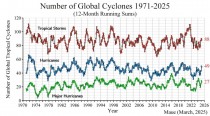
A graph of global cyclone
AI-generated content may be incorrect.
Efforts to enact “superfund” laws to seek monetary damages from fuel companies are also underway in California and Massachusetts. Voters rejected a similar proposed statute this month in Oregon. But Maryland, New York, and Vermont laws have serious legal weaknesses. The Constitution explicitly states that neither the Congress nor any state may pass an “ex post facto Law,” which imposes criminal liability for past actions that weren’t restricted at the time. The Maryland, New York, and Vermont acts all propose to tax companies retroactively for legally producing fossil fuels.
The 1970 Clean Air Act gives the Environmental Protection Agency the responsibility for establishing air pollution standards. States have responsibility for local and indoor air pollution, but not nationwide or global air pollution, as the superfund laws appear to cover.
In addition to superfund laws, more than 24 states and many cities and counties have sued companies for damages related to climate change during the last five years. Some of these suits have been defeated, but most are still in process or in appeal. To date, none of these suits have been awarded monetary damages against the fuel companies.
California, Oregon, Washington, and 10 Northeast states have cap-and-trade laws. These laws require companies that emit CO2 to buy allowances in trading markets and then deliver them to state governments based on their emission levels. Such systems raise costs for businesses and consumers. President Trump’s executive order mentions these cap-and-trade laws, so expect challenges from the federal government.
Earlier this week, the US Department of Justice filed suits against four states, Hawaii, Michigan, New York, and Vermont, opposing their climate laws against hydrocarbon fuel companies. Expect these state “extortion laws” to be struck down. The Trump administration has added the power of the federal government to energy companies’ challenges of state climate statutes.
Steve Goreham is a speaker on energy, the environment, and public policy and author of the bestselling book Green Breakdown: The Coming Renewable Energy Failure.
May 04, 2025
Invitation
Michigan Event
Steve Goreham and Dr. Calvin Beisner will be speaking in Grand Rapids the evening of Friday, May 23, from 7-10 PM Eastern time. The topic will be:
Climate Change: Fact or Fantasy?
Location: GR.Church, 4525 Stauffer Avenue, Grand Rapids, MI 49508
Tickets and Information

Please buy tickets and plan to attend if you are in the area.
----------
Below are two recent articles.
Time to Defund the Climate Models?
Published in MasterResource, April 29, 2025.
Climate models have been the basis for concern about climate change for more than 35 years. The US government, the United Nations, and organizations across the world have used model projections to warn about global warming and to demand a shift to renewable energy. But Trump administration budget cuts at NASA, NOAA, and other federal agencies threaten to shut down the models, the heart of climate change alarmism.
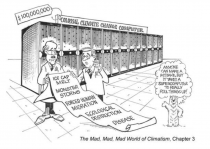
Cartoon of men holding a sign in front of lockers
US Military Exits Climate Change after a Decade of Waste.
Published in MasterResource, April 2, 2025.
The United States military has pursued an increasing number of programs to try to fight climate change for more than a decade. The air force, army, and navy each developed programs to use alternative energy and to reduce hydrocarbon-based fuels, with aggressive carbon dioxide (CO2) emissions reduction plans. But under the Trump Administration, climate change mitigation will no longer be an objective of the US military.
A logo of a navy ship

Globally warm regards,
Steve
Steve Goreham
stevegoreham.com
815-275-9532
Feb 26, 2025
RGGI more than doubles electrical costs for residents and all consumer sectors
Joseph D’Aleo ICECAP
First the softsell
Greenhouse Gas Initiative
The Regional Greenhouse Gas Initiative (RGGI) is a cooperative effort among eleven Eastern states to reduce carbon dioxide (CO2) emissions from power plants within each participating state.Together, the participating states have established a regional cap on CO2 emissions, which sets a limit on the emissions from regulated power plants within the RGGI states.
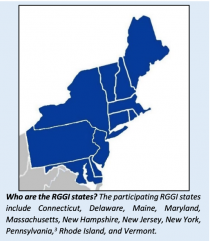 Enlarged Enlarged
When you list the states with the highest electricity prices for the residential sector, the list has the RGGI states and no surprise California.
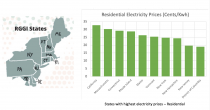 Enlarged Enlarged
The lowest prices were in statesnd that have common sense energy policies.
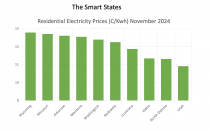 Enlarged Enlarged
The same holds for all energy user sectors - first highest prices and then lowest prices.
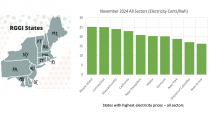 Enlarged Enlarged
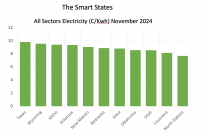 Enlarged Enlarged
The RGGI Fact sheet tries to sell the benefits to the state and users.
Regional Greenhouse Gas Initiative
The Regional Greenhouse Gas Initiative (RGGI) is a cooperative effort among eleven Eastern states to reduce carbon dioxide (CO2) emissions from power plants within each participating state. Together, the participating states have established a regional cap on CO2 emissions, which sets a limit on the emissions from regulated power plants within the RGGI states. Over time, the regional cap declines, so that CO2 emissions decrease in a planned and predictable way.
Since 2005, the RGGI 10 states have reduced annual power sector emissions 50%, which is almost 50% faster than the nation as a whole, and have so far raised over $8.6 billion to invest into local communities. How Does RGGI Work? Within the RGGI states, certain power plants must acquire one RGGI CO2 allowance for every short ton of CO2 they emit. The RGGI states distribute these allowances at quarterly auctions, where they can be purchased by power plants and other entities.
Some states hold a limited number of allowances in set-aside accounts to sell at a fixed price or otherwise distribute outside of the auction process. Once an allowance is distributed, it can be held and traded, which creates a secondary market for allowances.
Feb 20, 2025
70+ scientific papers say: Today’s Sea Level Change Indistinguishable From Noise
Anthony Watts, WUWT
Holocene Sea Levels were 2 Meters Higher
1. Are Modern ‘Anthropogenic’ Sea Levels Rising At An Unprecedented Rate? No.
Despite the surge in CO2 concentrations since 1900, the UN’s Intergovernmental Panel on Climate Change (IPCC) has concluded that global sea levels only rose by an average of 1.7 mm/yr during the entire 1901-2010 period, which is a rate of just 0.17 of a meter per century.
During the 1958 to 2014 period, when CO2 emissions rose dramatically, a recent analysis revealed that the rate of sea level rise slowed to between 1.3 mm/yr to 1.5 mm/yr, or just 0.14 of a meter per century.
Frederiske et al.,2018 “Anthropogenic” Global Sea Level Rise Rate (1958-2014): +0.14 of a meter per century
“For the first time, it is shown that for most basins the reconstructed sea level trend and acceleration can be explained by the sum of contributors, as well as a large part of the decadal variability. The global-mean sea level reconstruction shows a trend of 1.5 +/- 0.2 mm yr−1 over 1958-2014, compared to 1.3 +/- 0.1 mm yr-1 for the sum of contributors.”
2. ~15,000 - 11,000 Years Ago, Sea Levels Rose At Rates Of +4 to +6 Meters Per Century
In the past few thousand years, sea levels in some regions rose and fell at rates of + or - 0.5 to 1.1 meters per century. Sea levels during the Medieval Warm Period were+170 centimeters higher than today.
Hansen et al., 2016 Denmark, +1.7 meters higher than present during the Medieval Warm Period
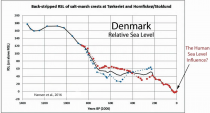
“Continuous record of Holocene sea-level changes ... (4900 years BP to present). ... The curve reveals eight centennial sea-level oscillations of 0.5-1.1 m superimposed on the general trend of the RSL [relative sea level] curve [relative sea levels ~1.7 m higher than present from 1400 to 1000 years ago].”
Cronin et al., 2017 Global Sea Level Rise Rate: +4 meters per century (14,500 to 14,000 years ago)
“Rates and patterns of global sea level rise (SLR) following the last glacial maximum (LGM) are known from radiometric ages on coral reefs from Barbados, Tahiti, New Guinea, and the Indian Ocean, as well as sediment records from the Sunda Shelf and elsewhere. ... Lambeck et al. (2014) estimate mean global rates during the main deglaciation phase of 16.5 to 8.2 kiloannum (ka) [16,500 to 8,200 years ago] at 12 mm yr−1 [+1.2 meters per century] with more rapid SLR [sea level rise] rates (∼ 40 mm yr−1) [+4 meters per century] during meltwater pulse 14.5-14.0 ka [14,500 to 14,000 years ago].”
Abdul et al., 2017 Global Sea Level Rise Rate: +4 meters per century(11,450 to 11,100 years ago)
“We find that sea level tracked the climate oscillations remarkably well. Sea-level rise was fast in the early Allerod (25 mm yr-1), but decreased smoothly into the Younger Dryas (7 mm yr-1) when the rate plateaued to <4 mm yr-1 here termed a sea-level "slow stand". No evidence was found indicating a jump in sea level at the beginning of the Younger Dryas as proposed by some researchers. Following the "slow-stand", the rate of sea-level rise accelerated rapidly, producing the 14 +/- 2 m sea-level jump known as MWP-1B; occurred between 11.45 and 11.1 kyr BP with peak sea-level rise reaching 40 mm yr-1 [+4 meters per century]."
Ivanovic et al., 2017 Northern Hemisphere Sea Level Rise Rate: +3.5 to +6.5 meters per century (~14,500 years ago)
"During the Last Glacial Maximum 26-19 thousand years ago (ka), a vast ice sheet stretched over North America [Clark et al., 2009]. In subsequent millennia, as the climate warmed and this ice sheet decayed, large volumes of meltwater flooded to the oceans [Tarasov and Peltier, 2006; Wickert, 2016]. This period, known as the "last deglaciation," included episodes of abrupt climate change, such as the Bolling warming [~14.7-14.5 ka], when Northern Hemisphere temperatures increased by 4-5C in just a few decades [Lea et al., 2003; Buizert et al., 2014], coinciding with a 12-22 m sea level rise in less than 340 years [3.5 to 6.5 meters per century] (Meltwater Pulse 1a (MWP1a)) [Deschamps et al., 2012]."
Zecchin et al., 2015 Regional Sea Level Rise Rate: +6 meters per century(14,500-11,500 years ago)
"[M]elt-water pulses have punctuated the post-glacial relative sea-level rise with rates up to 60 mm/yr. [6 meters per century] for a few centuries."
3. Over 70 Papers Affirm Sea Levels Were 2+ Meters Higher Than Now A Few Thousand Years Ago When CO2 Levels Were 'Safe'.
70+ Papers: Sea Levels 2+ m Higher 9,000-4,000 Years Ago While CO2 Levels Were 'Safe' (265 ppm) More Here
Before the advent of the industrial revolution in the late 18th to early 19th centuries, carbon dioxide (CO2) concentrations hovered between 260 to 280 parts per million (ppm).
Within the last century, atmospheric CO2 concentrations have risen dramatically. Just recently they eclipsed 400 ppm.
Scientists like Dr. James Hansen have concluded that pre-industrial CO2 levels were climatically ideal. Though less optimal, atmospheric CO2 concentrations up to 350 ppm have been characterized as climatically “safe”.
However, CO2 concentrations above 350 ppm are thought to be dangerous to the Earth system. It is believed that such “high” concentrations could lead to rapid warming, glacier and ice sheet melt, and a harrowing sea level rise of 10 feet within 50 years.
To reach those catastrophic levels (10 feet within 50 years) predicted by proponents of sea level rise alarmism, the current “anthropogenic” change rate of +0.14 of a centimeter per year (since 1958) will need immediately explode into +6.1 centimeters per year.
The likelihood of this happening is remote, especially considering Greenland and Antarctica combined only contributed a grand total of 1.54 cm since 1958 (Frederiske et al., 2018).
It is becoming more and more apparent that sea levels rise and fall without any obvious connection to CO2 concentrations.
And if an anthropogenic signal cannot be conspicuously connected to sea level rise (as scientists have noted), then the greatest perceived existential threat promulgated by advocates of dangerous man-made global warming will no longer be regarded as even worth considering.
Read more at No Tricks Zone
Feb 05, 2025
Trump Drops a Bomb on Green Energy
By Steve Goreham
Originally published in MasterResource.
President Trump has long been a supporter of traditional energy. During his campaign, he spoke negatively about electric vehicles, wind, and other renewable energy sources. But in his first day in office, the new president began a historic shift in US energy policy, away from green energy and back to hydrocarbon energy.
On January 20, 2025, President Trump signed five wide-ranging executive orders that radically change United States energy and climate policy. These actions restore efforts to promote coal, natural gas, oil, hydropower, nuclear, and biofuels, while curtailing support for wind and electric vehicles. The Trump executive orders also rescinded orders issued by President Biden and closed federal departments established to promote climate change policies and green energy.
The executive order regarding “offshore wind” and “wind projects” immediately impacted the world wind industry. The US government owns all land from three miles to 200 miles offshore, so wind companies require a federal lease to build offshore systems. The order withdrew “all areas within the Offshore Continental Shelf” from wind leasing. The order also requires that the new Secretary of the Interior, Doug Burgum, “conduct a comprehensive review” to determine the necessity for “terminating or amending any existing wind energy leases” and to submit a report to the President. The order also put a hold on the Lava Ridge Wind Project in Idaho, pending a review by the Secretary of the Interior, a project which was approved by the Biden Administration in December.
Wind energy markets were shocked by Trump’s order. The stock price of Orsted, a Danish wind system supplier, dropped 17% to its lowest price in seven years. Orsted proposed to build Sunrise Wind, the largest planned US offshore wind system, to be located southeast of New York City. The company immediately took a $1.69 billion impairment charge on US wind projects.
Wind suppliers RWE of Germany, Equinor of Norway, Renovaveis of Portugal, and Vestas of Denmark also suffered stock price declines. Italy’s Prysmian announced that it would abandon a plan to build a plant in the US to make cables for offshore wind systems.
Wind energy plans for several states have been crippled. California planned to install 25 gigawatts of offshore wind energy by 2045, with initial projects at Morro Bay and Humbolt Bay, but these plans are on hold for at least the next four years. Maryland, Massachusetts, New Jersey, New York, North Carolina, South Carolina, Rhode Island, and Virginia are constructing or planning east coast offshore systems, but these programs will be reviewed, limited, or halted if not yet started.
The “Unleashing American Energy (UAE)” executive order calls for elimination of the “electric vehicle (EV) mandate” to promote consumer choice and access to gasoline-powered automobiles. It’s true that we have no formal EV mandate, but 22 states have zero-emissions vehicle laws or executive orders prohibiting sales of gasoline cars by a future date, typically 2035. On March 20 of last year, the Environmental Protection Agency (EPA) issued updated emissions standards that would force auto manufacturers to sell an increasing number of EVs, rising from about 8% last year to about 56% of new light vehicle purchases by 2032.
A map of the united states with green and white states
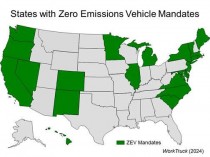
The Trump orders also call for termination of state emissions waivers “that function to limit sales of gasoline powered automobiles.” The 1970 Clean Air Act established the federal government as responsible for regulating pollution, except where a waiver is granted by the EPA to a state. For years, California has set emissions standards, receiving EPA waivers to do so, with other states following California’s lead. The orders seek to terminate these waivers to California and restore emissions control to the EPA. Earlier this month, California withdrew their request for a waiver for regulations to electrify heavy trucks and locomotives because it appeared that Trump’s EPA would not grant that request.
The order also calls for the “elimination of unfair subsidies and other ill-conceived government-imposed market distortions that favor EVs.” This probably refers to coming efforts to eliminate the $7500 tax credit on new EV sales and also efforts to eliminate the Corporate Average Fuel Economy standards issued by the Department of Transportation, which force auto manufacturers to sell a larger share of EVs.
The US economy today includes several green energy industries which probably would not exist without the vast array of federal and state subsidies and tax credits. Wind, solar, EV charging, carbon dioxide (CO2) capture, and green hydrogen receive a limitless stream of subsidies and tax credits from the Inflation Reduction Act (IRA) and the Infrastructure Investment and Jobs Act (IIJA), both of which were passed during the Biden Presidency. The CATO institute estimates that renewable energy will receive about $80 billion in federal funds during fiscal year 2025.
During his campaign, Mr. Trump vowed to eliminate the money flow from these two acts, and his first-day executive orders reflect this. The UAE order calls for “termination of the Green New Deal,” and a halt to the disbursement of funds from the IRA and IIJA. President Trump will probably need to pass Congressional legislation to permanently reduce the flow of IRA and IIJA funds.
Wind and solar systems are intermittent, use 100 times the land area, and require at least double the transmission infrastructure compared to traditional coal, gas, or nuclear power plants. Few utilities would build wind and solar systems if not for the fear of human-caused global warming. But the new executive orders make it clear that the US will no longer pursue efforts to “mitigate” climate change.
In the executive order titled “Putting America First in International Environmental Agreements,” the President directs the US Ambassador to the United Nations, nominee Elise Stefanik, to notify the UN in writing that the US withdraws from the Paris Climate Agreement, effective immediately. The order also states that the US will immediately cease financial payments under the Framework Convention on Climate Change.
The orders direct executive branch officials to cancel at least five Biden executive orders on climate change, and to disband the Climate Change Support Office, the American Climate Corps, and The Working Group on the Social Cost of Greenhouse Gases. The orders also call for the EPA to review the 2009 Endangerment Finding for “continuing applicability.” That finding concluded that carbon dioxide endangered US citizens and is the basis for regulating CO2 emissions in the US.
The Trump actions also seek to boost the development of hydrocarbon energy in the spirit of “drill, baby, drill.} Key actions include re-opening the licensing of liquified natural gas terminals, opening federal lands for onshore and offshore oil and gas production, reopening Alaska lands for energy production, and reducing efficiency regulations on dishwashers, stoves, and furnaces. The President also declared a national energy emergency to speed the deployment of pipelines and other energy infrastructure. The Trump EPA and Department of Energy will roll back regulations on oil and gas to expand US production.
Trump’s executive order bomb, followed by Congressional action to limit funds from the IRA and IIJA, promises to gut, or profoundly reshape, the US green energy movement. January 2025 may begin a long decline for green energy and a return to sensible energy policy.
Steve Goreham is a speaker on energy, the environment, and public policy and author of the bestselling book Green Breakdown: The Coming Renewable Energy Failure.
|














